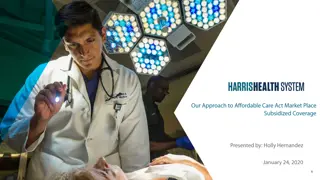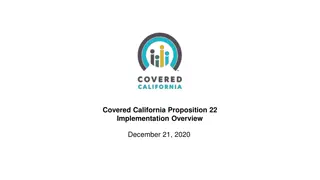Strategies for Lifting 100 Million Nigerians Out of Poverty
Fiscal pressures and rising prices are pushing millions into poverty in Nigeria. To address this, eliminating the PMS subsidy and implementing a targeted cash transfer program could help protect the poor and support the country's recovery. By communicating these strategies effectively, a significant impact can be made in reducing poverty and promoting economic stability.
Download Presentation

Please find below an Image/Link to download the presentation.
The content on the website is provided AS IS for your information and personal use only. It may not be sold, licensed, or shared on other websites without obtaining consent from the author.If you encounter any issues during the download, it is possible that the publisher has removed the file from their server.
You are allowed to download the files provided on this website for personal or commercial use, subject to the condition that they are used lawfully. All files are the property of their respective owners.
The content on the website is provided AS IS for your information and personal use only. It may not be sold, licensed, or shared on other websites without obtaining consent from the author.
E N D
Presentation Transcript
Lifting 100 million Nigerians out of poverty Options to eliminate the PMS subsidy, while protecting the poor and supporting the recovery October 28, 2021
CONTEXT: FISCAL PRESSURES THREATEN NIGERIAS RECOVERY, WHILE RISING PRICES ARE PUSHING MILLIONS INTO POVERTY Rising prices are pushing millions of Nigerians into poverty Between 2020 and 2021 the inflation shock is expected to have pushed an additional 5.6 million Nigerians into poverty Food insecurity is increasing in both poor and non-poor households, with some adults skipping meals Because inflation is high, even if it remains stable, it will continue to push many more Nigerians into poverty Fiscal pressures are growing unsustainably with the PMS subsidy significantly reducing the flow of revenues into the Federation Account The Federation s NET revenues from OIL and GAS between January and May 2021 were about HALF of what was anticipated in the budget: NGN 872 billion instead of NGN 1,736 billion, a shortfall of NGN 864 billion If crude oil prices and the cost of imported PMS remain at the current level and if the domestic retail price of PMS remains unchanged, that could result in FORGONE REVENUES of NGN 1.5 1.6 trillion in 2021 Moreover, this NGN 1.5 trillion in subsidy expenditures (forgone revenues) would primarily benefit rich Nigerians and those in neighboring countries: The bottom 40 percent of Nigerians buy only 3% of the total PMS subsidized by the government. Those with higher income consume much more petrol and therefore benefit far more than the poor from the PMS subsidy. Urban residents consume twice as much as rural residents. PMS prices today are NGN 200 300/liter higher in the neighboring countries, providing powerful financial incentives for smuggling, making the subsidy even more regressive.
POSSIBLE WAY FORWARD FOR THE PMS SUBSIDY: A STRATEGICALLY COMMUNICATED COMPACT WITH THE NIGERIAN PEOPLE Because inflation remains high, it needs to be contained and priorities for the near-term (3-6 months) are as follows: More flexible management of NAFEX, which we believe will help bring down the parallel rate, increases in which have been driving inflation (more credible and transparent exchange rate management would also attract investment) Signaling a commitment to price stability as the primary monetary policy objective Full reopening of the land borders Removal of FX restrictions on essential items Elimination of the PMS subsidy (and greater accountability and transparency around oil and gas revenues) are the only immediate options for easing fiscal pressures A move to full market-based pricing of PMS, accompanied by social assistance for the poor in the form of cash transfers (next bullet), would free up significant government spending, at least NGN 150 billion a month being deducted by the NNPC at the current global PMS price In parallel, a time-limited large-scale cash transfer program that quickly compensates Nigerians for lost purchasing power A large-scale & time-bound targeted cash-transfer program may be both fiscally affordable and politically necessary if developed and (strategically) communicated as one component of a broader package that mitigates adverse economic effects and protects the poor An USD 800 million program over 6 months could cover 6.5 million vulnerable households (~33 million Nigerians) in rural and urban areas with a monthly transfer of NGN 5,000 per household (what households currently get under the NASSP), plus 2 million poorest households with a monthly transfer of NGN 5,000 for 12 months Combined with a financial inclusion drive (BVN registration) and digital or mobile money payments, the program could be implemented more robustly while bringing millions of financially excluded Nigerians into the financial system USD 800 million is significantly less than the annualized cost of the PMS subsidy Critical that the package be strategically communicated as a compact with the Nigerian people
POSSIBLE WAY FORWARD: 3 PARALLEL STEPS Subsidy removal, cash transfer, and communication campaign must kick-in at same time for a social compact to be credible 1. ELIMINATE THE PMS SUBSIDY 2. LAUNCH LARGE SCALE TIME-LIMITED CASH TRANSFER Aim to cover a large fraction of the population, possibly even the bottom half, building on the existing national social safety nets program (NASSP) and the Rapid Response Register (RRR) launched as part of the COVID- 19 pandemic response Today, using the existing NASSP and available and authorized financing, FGN has about USD 200 million to spend enough to roughly cover 8 million vulnerable households in rural and urban areas with a monthly transfer of NGN 5,000 per household for 2 months Further budget authorization for a scaled-up cash transfer could be sought through the ongoing deliberations on the 2022 Budget (NOTE that the 2022 Budget Proposal assumes a provision for the PMS subsidy) Announce that the large-scale time-bound cash-transfer program will start in January 2022. Ensure transfers are made at same time that one-off subsidy removal kicks in One option is to increase the price by a fixed price at a regular interval. India phased out its diesel subsidy by raising the price by the same amount every month for 20 months from Jan 2013 to Aug 2014. BUT this would be TOO LONG for Nigeria and is NO LONGER fiscally responsible. However, shortening the duration of fixed price increases to just 3 months (e.g., JAN-MAR) would require a monthly increase of NGN 45/liter or so, which would encourage hoarding and continue social unrest. Hence a difficult balancing act. The best option at this stage: Move immediately to market- based pricing with no under-recoveries. This would mean an increase of about NGN 135/liter in January 2022 This needs to go hand in hand with a sufficiently large cash transfer to the poor to avoid any rise in poverty associated with fuel subsidy reform Timing of subsidy removal should thus be linked to readiness of cash transfer program 3. STRATEGICALLY COMMUNICATE ON THE LINK BETWEEN THE TWO At same time, communicate a compact with the Nigerian people, comprising a package of reforms including a time-limited cash transfer program to the bottom half of the population, to be financed through the elimination of PMS subsidy
WHAT A POSSIBLE LARGE-SCALE ROLLOUT OF CASH TRANSFERS COULD LOOK LIKE KEY PARAMETERS (TBC): TARGET BENEFICIARIES: at least 20 million households (between 100 and 120 million people), roughly the bottom half of the population TIME-FRAME: each household would receive cash transfers over a period 6 months SIZE OF TRANSFER: each household would receive NGN 5,000 per month, possibly in two installments of NGN 15,000 OVERALL COST: NGN 100 billion per month or NGN 600 billion in total over 6 months. By comparison, monthly cost of PMS subsidy at current import costs and average daily consumption is about NGN 240 billion per month or NGN 1,440 billion over 6 months Signaling a commitment to price stability as the primary monetary policy objective Full reopening of the land borders Removal of FX restrictions on essential items IMPLEMENTATION CONSIDERATIONS TIMING & IMPLEMENTATION READINESS: If it were to be announced and initiated in January 2022, given current status of platforms and delivery systems under the National Social Registry and the Rapid Response Register, between 10-12 million households could immediately receive the initial installment with the remaining 8-10 million households registered and receiving the initial installment between January 2022 and March 2022 ROLE AND OWNERSHIP OF STATES VS. FEDERAL GOVERNMENTS: NASSP and RRR currently implemented by FGN but through State Offices under the State Governments. Role of states and greater ownership and visibility would be needed COORDINATION: the three pillars PMS subsidy removal, large scale rollout of cash transfer and strategic communications at the federal and state level would need to be coordinated and move in a synchronized fashion FINANCING 2022 budget? USD 800 million World Bank credit under preparation?























